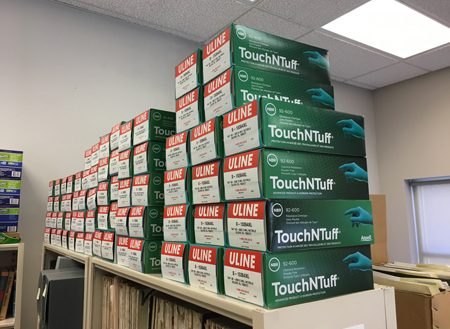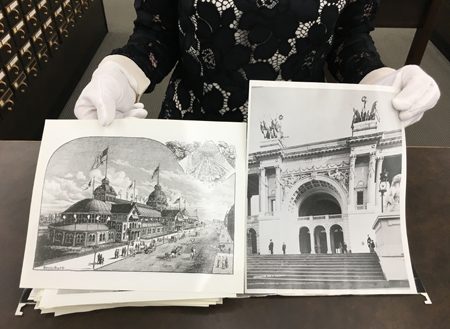When you work at a museum, you wear specific gloves when handling certain artifacts, most of the time. Researchers and visitors often ask us why, so here’s a bit more about why we love our gloves.

Just a portion of the glove supply in the Collections office. All images by Esther Wang
At the Chicago History Museum, we most frequently wear powder-free nitrile gloves, as nitrile is a rubber that will not transfer contaminants between artifacts and the staff handling them, like vinyl and latex can. Latex is also avoided due to the frequency of allergies, and the gloves must be powder-free so that the objects do not get contaminated. Nitrile gloves are typically used to handle artifacts such as textiles, paintings, and other three-dimensional objects, like this teapot from the mid-1800s.

CHM senior collection manager Britta Keller Arendt handles a recently acquisitioned artifact.
The Research Center has patrons wear cotton gloves when handling photographic material to avoid transferring fingerprints, as the oil produced by our fingers can damage photographs in the long term. Only a limited selection of books and papers also require users to wear gloves, depending on their age and composition, because while gloves offer protection, they also limit the wearer’s dexterity, which increases the risk of mishandling an object.

Archivist Julie Wroblewski wears cotton gloves while handling photographic prints.
However, in most cases, we won’t wear gloves at all when working with paper materials as it’s more important for the handler to have maximum dexterity and avoid accidentally snagging gloves on the artifact. In such situations, staff members are diligent about washing their hands prior to working with the object.

Julie carefully handles a signed letter that Martin Luther King Jr. sent to Mahalia Jackson.
Finally, gloves are especially important during the acquisition process. Collections are sometimes donated as unsorted materials in boxes, and staff members wear gloves in order to protect themselves from the unknown contents. It’s possible that the objects have experienced mold or pest problems or have been treated with pesticides before their arrival at CHM.
Now that you know how the professionals do it, you can help protect and extend the life of your family heirlooms by wearing gloves! Nitrile gloves can be purchased at your local pharmacy, as they’re frequently used by home health care providers.
For more on glove usage, check out this handy guide from the National Park Service.
Assistant editor Esther D. Wang spoke to senior collection manager Britta Keller Arendt and archivist for archives and manuscripts Julie Wroblewski for this blog post.